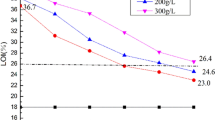Abstract
Monochlorotriazine aminopropyl silanol phosphate (MCASP) was synthesized as a novel flame retardant agent for cotton fabric. It was characterized by FTIR, 1H, 13C and 31P NMR. The flame retardancy of the cotton fabric treated with MCASP was characterized by limiting oxygen index (LOI), and the vertical burning test. The cotton fabric treated with 300 g L−1 MCASP obtained the best flame retardancy with a LOI value of 31.0%, and the char length decreased to 4.5 cm. Combustion behaviors of treated cotton fabric were tested by cone calorimeter. The ignition time increased, and the values of total heat release, heat release rate, mass loss decreased. The surface morphology of the residues and the thermal stability of cotton fabric were investigated by scanning electron microscopy and thermogravimetric analysis, respectively. The chemical structure of residue of treated cotton fabric was studied by FTIR. The results showed that MCASP played a protective role on the degradation of cotton fabric, hindered the formation of volatile species and favored the formation of char. What is more, the strength and durability of treated fabric were studied by tear force test and washing durability test, respectively.












Similar content being viewed by others
References
Mostashari SM, Mostashari SZ. Combustion pathway of cotton fabrics treated by ammonium sulfate as a flame-retardant studied by TG. J Therm Anal Calorim. 2008;91:437–41.
Zhou L, Liang Z, Li R, et al. Flame-retardant treatment of cotton fabric with organophosphorus derivative containing nitrogen and silicon. J Therm Anal Calorim 2016;128(2):1–8.
Weil ED, Levchik SV. Flame retardants in commercial use or advanced development in polyurethanes-flame retardants. J Fire Sci. 2008;26(1):197–225.
Martin C, Hunt BJ, Ebdon JR, Ronda JC, Cadiz V. Synthesis, crosslinking and flame retardance of polymers of boron-containing difunctional styrenic monomers. React Funct Polym. 2006;66(10):1047–54.
El-Shafei A, Elshemy M, Abou-Okeil A. Eco-friendly finishing agent for cotton fabrics to improve flame retardant and antibacterial properties. Carbohyd Polym. 2015;118:83–90.
Kappes RS, Urbainczyk T, Artz U, et al. Flame retardants based on amino silanes and phenylphosphonic acid. Polym Degrad Stab. 2016;129:168–79.
Vasiljević J, Hadžić S, Jerman I, et al. Study of flame-retardant finishing of cellulose fibres: organic–inorganic hybrid versus conventional organophosphonate. Polym Degrad Stab. 2013;98(12):2602–8.
Alongi J, Colleoni C, Rosace G, Malucelli G. Thermal and fire stability of cotton fabrics coated with hybrid phosphorus-doped silica films. J Therm Anal Calorim. 2012;110:1207–16.
Chen YZ, Peng HQ, Li JH, Xia ZX, Tan H. A novel flame retardant containing phosphorus, nitrogen, and sulfur: synthesis and application in thermoplastic polyurethane. J Therm Anal Calorim. 2014;115:1639–49.
Zhao P, Liu S, Xiong K, et al. Highly flame retardancy of cotton fabrics with a novel phosphorus/nitrogen/silicon flame-retardant treating system. Fiber Polym. 2016;17(4):569–75.
Deh S, Gähr F, Buchmeiser MR. Synergistic effects in the pyrolysis of phosphorus-based flame-retardants: the role of Si- and N-based compounds. Polym Degrad Stab. 2016;130:155–64.
Zhou T, He X, Guo C, et al. Synthesis of a novel flame retardant phosphorus/nitrogen/siloxane and its application on cotton fabrics. Text Res J. 2015;85(7):701–8.
Przybylak M, Maciejewski H, Dutkiewicz A, et al. Multifunctional, strongly hydrophobic and flame-retarded cotton fabrics modified with flame retardant agents and silicon compounds. Polym Degrad Stab. 2016;128:55–64.
Wang S, Sui X, Li Y, et al. Durable flame retardant finishing of cotton fabrics with organosilicon functionalized cyclotriphosphazene. Polym Degrad Stab. 2016;128:22–8.
Ballesterosgómez A, De BJ, Leonards PE. A novel brominated triazine-based flame retardant (TTBP-TAZ) in plastic consumer products and indoor dust. Environ Sci Technol. 2014;48(8):4468–74.
Yang K, Xu MJ, Li B. Synthesis of N-ethyl triazine-piperazine copolymer and flame retardancy and water resistance of intumescent flame retardant polypropylene. Polym Degrad Stab. 2013;98(7):1397–406.
Yang Z, Wang X, Lei D, et al. A durable flame retardant for cellulosic fabrics. Polym Degrad Stab. 2012;97(11):2467–72.
Yang CQ, He Q, Lyon RE, et al. Investigation of the flammability of different textile fabrics using micro-scale combustion calorimetry. Polym Degrad Stab. 2010;95(2):108–15.
Nguyen TD, Chang SC, Condon B, et al. Development of an environmentally friendly halogen-free phosphorus-nitrogen bond flame retardant for cotton fabrics. Polym Adv Technol. 2012;23(12):1555–63.
Edwards B, Rudolf S, Hauser P, et al. Preparation, polymerization, and performance evaluation of halogen-free radiation curable flame retardant monomers for cotton substrates. Ind Eng Chem Res. 2015;54(2):150109100032004.
Li Z, Song T, Liu J, et al. Thermal and combustion behavior of phosphorus-nitrogen and phosphorus-silicon retarded epoxy. Iran Polym J. 2017;26:21–30.
Nazare S, Kandola B, Horrocks AR. Smoke, CO and CO2 measurements and evaluation using different fire testing techniques for flame retardant unsaturated polyester resin formulations. J Fire Sci. 2008;26:215–42.
Liu Y, Zhao JC, Zhang CJ, et al. Effect of manganese and cobalt ions on flame retardancy and thermal degradation of bio-based alginate films. J Mater Sci. 2016;51(2):1052–65.
Xu M, Zhao W, Li B. Synthesis of a novel curing agent containing organophosphorus and its application in flame-retarded epoxy resins. J Appl Polym Sci. 2015;131(23):e51793.
Tsafack MJ, Levalois-Grutzmacher J. Flame retardancy of cotton textiles by plasma-induced graft-polymerization (PIGP). Surf Coat Technol. 2006;201:2599–610.
Alongi J, Ciobanu M, Carosio F, Tata J, Malucelli G. Thermal stability and flame retardancy of polyester, cotton and relative blend textile fabrics treated by sol-gel process. J Appl Polym Sci. 2011;119:1961–9.
Acknowledgements
This work was supported by the Scientific Research Foundation for the Returned Overseas Chinese Scholars, State Education Ministry (Grant no. 48).
Author information
Authors and Affiliations
Corresponding authors
Rights and permissions
About this article
Cite this article
He, P., Chen, X., Zhu, P. et al. Preparation and flame retardancy of reactive flame retardant for cotton fabric. J Therm Anal Calorim 132, 1771–1781 (2018). https://doi.org/10.1007/s10973-018-7057-6
Received:
Accepted:
Published:
Issue Date:
DOI: https://doi.org/10.1007/s10973-018-7057-6




